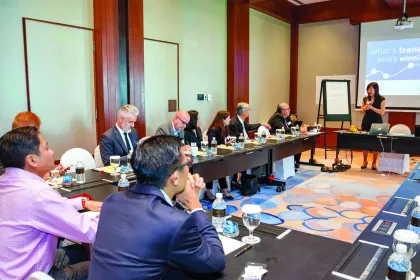
What's trending? What's winning?
In the face of relentless competition, tight squeeze on margins and elusive customer demands, Asia-Pacific retailers are working hard to be faster, better and to deliver a compelling value proposition.
Sharon Tian sits in at the Retail Asia - Pacific Top 500 Trends & Strategies Roundtable and hears how retailers are learning, unlearning and relearning to win the battle.
IT was not the usual conference of speakers and listeners. When Asia-Pacific top retailers and experts gathered for a roundtable session on retail trends and strategies, there was energy in the air and passionate discussion about global trends affecting the retail business, what keeps them awake at night and the strategies they are adopting to help their business.
Dr Lynda Wee, founder and chief executive of Bootstrap, started the session with a presentation on how things have changed, citing actual cases of retail gamechangers.
Buying spectacles in Singapore has gone from functional to fashionable. In days not too long ago, we would go to an eye-care professional or optician to get our vision tested and probably wait a few days to over a week to collect our new pair 28 October 2016 Sofitel Singapore Sentosa Resort & Spa, Singapore www.retailasiaonline.com of spectacles. It was a strictly functional experience. Now, with the entry of players such as Owndays, it is fast and affordable. We can get our new eyewear as quickly as 20 minutes after payment and with the wide range of stylishly designed and affordably-priced products we can be easily persuaded to own a few pairs of eye wear.
“It is no longer about functional. You can go fashionable,” enthused Dr Wee.
Courts Asia was cited as another game-changer. The IT, electronics and home appliances distributor has long adopted a strategy of organising lifestyle events such as cooking classes, product demonstrations, auctions and themed parties to draw consumers into its stores.
Recently, it has focused efforts in the Health, Fitness & Wellness product category, establishing Courts’ World of Wellness as a one-stop destination for health and fitness products, including fitness trackers. Courts is meeting the trend of tech-savvy consumers who are increasingly health-conscious.
Responding to customers on their own terms
Retailers learn fast to keep up with consumer trends. Dr Wee observes that retailers are having to deal with “modern consumers who want to live life on their own terms”, and often are looking for mix-and-match buys. This creates the opportunity for aspirational local brands to share the pie with global brands.
In response to this trend, malls are into lifestyle experiences. For example, the new Funan Mall, now undergoing redevelopment to catch up with the times, will be a live-work-play mall that will feature a drive-through shopping service, an indoor cycling lane that cuts through the mall, areas for socialisation, education, shopping and even spaces for climbing, gym work and an urban farm. No longer just focused on IT, the redeveloped Funan Mall will be an “experiential creative hub”.
Similarly, the Project Jewel at Singapore Changi Airport promises rich brand experiences and collaborations with global and local labels that will turn shopping trips into journeys of discovery and multi-dimensional concepts that will charm even the most well-travelled.
Dr Wee’s point with these examples?
Retailers need to learn, unlearn and relearn, so that they are not left behind. “Retailers need digital skills, change management skills, cultural skills, and at the same time, learn to be S.E.X.Y — be a Strategic thinker, Executor, cultivate an X-factor and be a Yield generator.”
Being compelling and authentic
While Dr Wee outlined the retail landscape, the next speaker was focused on the day-to-day challenges of every retailer. Professor Leigh Sparks from the Institute of Retail Studies, University of Stirling, was quick to outline three shopping trends that are having immediate and daily impact on the cash registers.
“First, convenience and ease. We are well used to the notion of convenience and of convenience stores, but I really mean more than that. This is about convenience in people’s lives, whether digital or physical, in time or space terms and about how retailers have to make their offer not only convenient but also easy to use.” Professor Sparks said that the store or the offer cannot be difficult or it destroys the point for many consumers. “It is not also only about speed, but these ideas are related and slowness is often a customer killer.”
Professor Sparks also pointed to the need to be compelling and authentic. “Retailers need to make ‘statements’ about their position and offer and do this through the way they put together their operations. Retail stores need to shout their message and proposition through all that the store or website does and says. But again, how often is the offer or store confused and cluttered?” When retailers are able to convey a compelling and authentic position, they clearly demonstrate that they know what they are doing, operationally and in terms of customer’s needs. “But, too often, this is not the case.”
Thirdly, shoppers want to be engaged and entertained. “Engagement has many forms, covering brand, experience, product, price, creation and market, among others, and not all consumers want the same thing or level or type of engagement. That is why the best retailers are focusing on customer creation of the experience and the level of engagement or, in some cases, entertainment.” Professor Sparks cautioned that while consumers often want to be engaged and entertained, it is on their terms, and to be entertained not by others, through their own or their group’s activities. This is as important in the digital as in the physical space.
Disruptive technologies and retail disruptors
The task of providing a glimpse into the future of retail fell to Anson Bailey, partner, Business Development, KPMG in China, who skilfully led the audience to see how the confluence of several industry trends is affecting the retail game in a big way.
Sitting in a newly formed team in KPMG called High Growth Tech and Innovation, Bailey is often at the start of conversations on innovative ideas and discussions with big retailers and small startups on “disruptive technologies”.
“I am seeing that innovation is very important in today’s business everywhere, not just retail, and widely recognised to be so. KPMG clients are also recognising that technology is a vital enabler in their business.
“We talk about change in the retail industry. One thing we have yet to realise is the speed of change. KPMG has many traditional retail clients but increasingly, we are also dealing with a lot of new upstarts — small, local SMEs or startups who come with fresh innovative ideas and possibly become retail disruptors.”
Big companies are not slow on the uptake too, according to Bailey. “In many conversations with many MNCs in the FMCG sector, they increasingly want to talk about innovation, innovation, innovation. They want to talk about smart cities, robotics, AI (artificial intelligence), fintech, data and digitisation.
“Among the big companies, we are seeing accelerators. Corporates are offering mentorship programmes for entrepreneurs and instigating innovation for the industry. An example is AIA focusing on wearable technology and healthcare. Why are they doing this? Because they are looking at innovation, collaboration, working together as the way forward. Innovation and collaboration is the new oil, new currency of business.
“Today we live in a ‘mobile-first’ economy. Mobile-first economy actually means access anywhere, anytime. Think about the cost of entry to markets, ease of access, the industry blur that is going on now, and of course, absolutely there is a need to innovate.”
According to Bailey, another big retail disruptor is uberisation, a model which enables operators to exchange under utilised capacity of existing assets with close-to-zero transaction cost. “In China and across South-east Asia, I am now dealing with companies that are two or three years old who claim that they are the new Ubers of retail, new Ubers of logistics, and they are growing at a phenomenal pace, really moving up that value chain very, very quickly.”
Another big trend is connectivity. “Everything will be connected: 15 billion Internet devices last year, 50 billion devices in 2020. Connected devices, connected phones and connected office. That is going to be big trend. KPMG customers are now talking about data, data, data.”
Connectivity and the data explosion will bring about a whole new level of retail applications. “We are going to see massive change in the retail landscape and the relationship with technology is going to be the key driver. Think ROSS, the new AI lawyer powered by IBM. Think maybe of ROB, the digital retailer. It’s already a reality.”
Bailey cites the Expert Personal Shopper introduced by The North Face as an example of harnessing cognitive computing technology for retail. “Will this impact traditional retailers? You bet.”
Many more cases of retail innovation have fuelled Bailey’s optimism about the retail industry. “Recently, I met GROM, a Dutch entrepreneurial company which was trying to introduce the first 3D-printed orthopaedic footwear. The company is now working with several clinics in Hong Kong.
“The Mills in Hong Kong is a repurposed textile mill that is now an experiential retail landmark, a business incubator for tech-style startups and partnerships in fashion, textile and technology, as well as an arts and cultural institution for textile arts and culture,” said Bailey.
“Li & Fung, a traditional Hong Kong trading business, just opened Explorium in Shanghai, a data analytics hub and research and learning lab. On weekdays it’s a B2B place, on weekends they bring all the families and kids in, so you got retailer experience, tech exploration and entertainment.”
At the end of his presentation, Bailey could not resist a rally call. “A lot of you guys, retailers, are going to get punched in the face. What’s your plan?”
Top retail trends for Asia-Pacific retailers
A highly interactive and hands-on session after the presentations involved the roundtable participants in a vote on the top retail industry trends and what they see as the most important challenges for their business.
Asia-Pacific retailers called out these trends for attention:
1 Convenience.
Consumers are expecting anytime, anywhere, anyhow shopping experiences. The challenge is how to make it convenient and easy for the customer, including online and mobile consumers, to shop and pay.
2 Data mining.
With the proliferation of sensing and data collection technologies and data analytics, today’s retailers have a big opportunity to use technology to increase their understanding of customer needs and wants.
3 Retail entertainment.
The ability to keep customers engaged in the store and with the brand is a tremendous competitive advantage. The challenge is equally huge when the 21st century shopper is a globally connected consumer who demands to be engaged and entertained on their own terms and who often wants to be entertained by authentic, self-created experiences.
4 Providing value.
Value used to be associated with quality but now cost and price are key. Retailers need to figure out the best value proposition in terms of not only product quality, but also price of purchase and affordability.
5 Innovation in the supply chain.
Perhaps a little overlooked, but innovation in the supply chain is critical for improving business efficiency. It is an important support for the goal of cost efficiency and value creation in the business.

![]()



















 Advertise
Advertise







